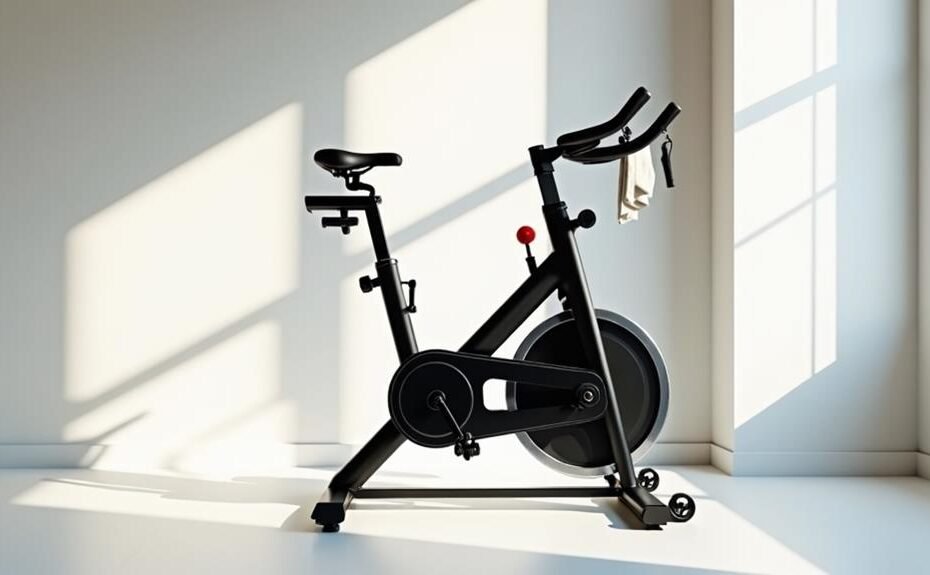When we examine the evolution of home fitness equipment, we'll find that spin bikes have emerged as one of the most significant innovations in cardiovascular training. These sophisticated machines combine the mechanical precision of road cycling with the convenience of indoor workouts, offering users a compelling blend of performance metrics and customizable resistance. While many assume that all spin bikes deliver similar results, we've discovered that the vast differences in resistance mechanisms, drive systems, and digital integration capabilities can dramatically impact both the user experience and training outcomes. Let's explore how these variations influence your potential investment and fitness journey.
Benefits of Indoor Cycling
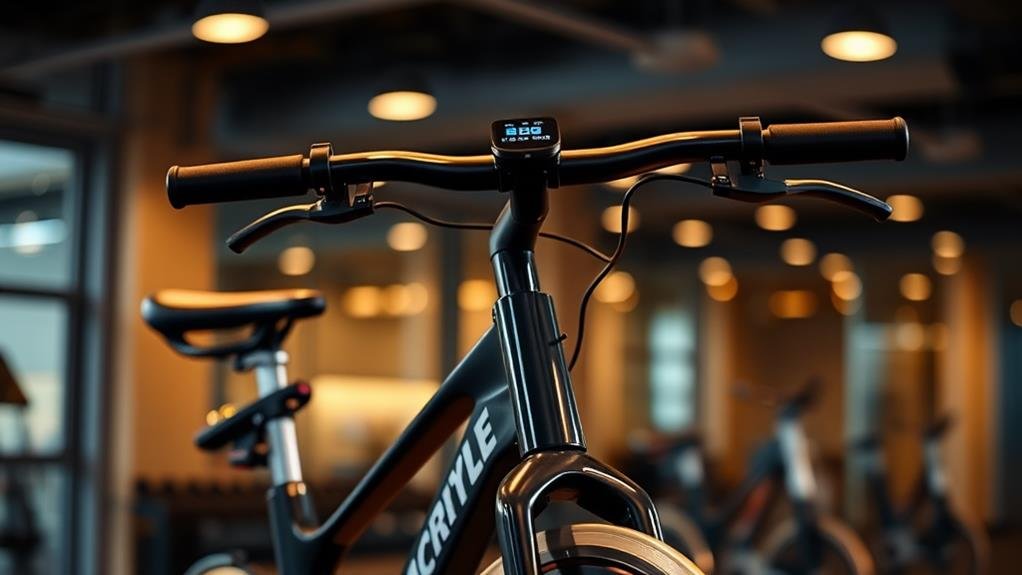
The benefits of indoor cycling extend far beyond basic exercise, offering a holistic approach to cardiovascular fitness that we can easily integrate into our daily routines. When we engage in regular indoor-cycling classes, we're participating in a low-impact activity that enhances our cardiovascular health while minimizing stress on our joints and connective tissues.
Using Spin bikes at home or in fitness facilities provides us with a scalable workout platform where we can precisely control intensity levels. By monitoring our effort with a heart-rate monitor, we're able to fine-tune our training sessions and track improvements in our cardiovascular fitness over time. This measurable approach allows us to adjust our workouts according to specific fitness goals and current capabilities.
We'll find that indoor cycling serves multiple purposes in our fitness journey. Whether we're rehabilitating from an injury, cross-training for other sports, or seeking a primary form of aerobic exercise, it's an adaptable solution.
The convenience of having access to this form of exercise, regardless of weather conditions or time constraints, ensures we can maintain consistency in meeting recommended weekly aerobic activity levels for maximum health benefits.
Types of Resistance Systems
Modern spin bikes come equipped with distinct resistance systems that fundamentally shape our workout experience. When we're choosing an IC4 Indoor Cycling bike or similar model, we'll encounter two primary resistance mechanisms: magnetic and mechanical systems.
Magnetic resistance has become the gold standard in premium spin bikes. We'll find that these systems utilize electromagnetic forces to create resistance, delivering an exceptionally smooth and quiet riding experience. The consistency of magnetic resistance allows us to maintain precise control over our workout intensity, making it ideal for structured training programs.
In contrast, mechanical resistance systems employ either friction-based or air resistance mechanisms. While these systems are typically found in more budget-friendly options, they're known to generate more noise during operation. When we're using bikes with mechanical resistance, we'll notice that the resistance feeling can vary slightly as components wear over time.
Understanding these differences is essential when selecting a spin bike. While both systems effectively create the resistance needed for a challenging workout, magnetic resistance offers superior performance and longevity, though often at a higher price point than its mechanical counterparts.
Key Features to Consider
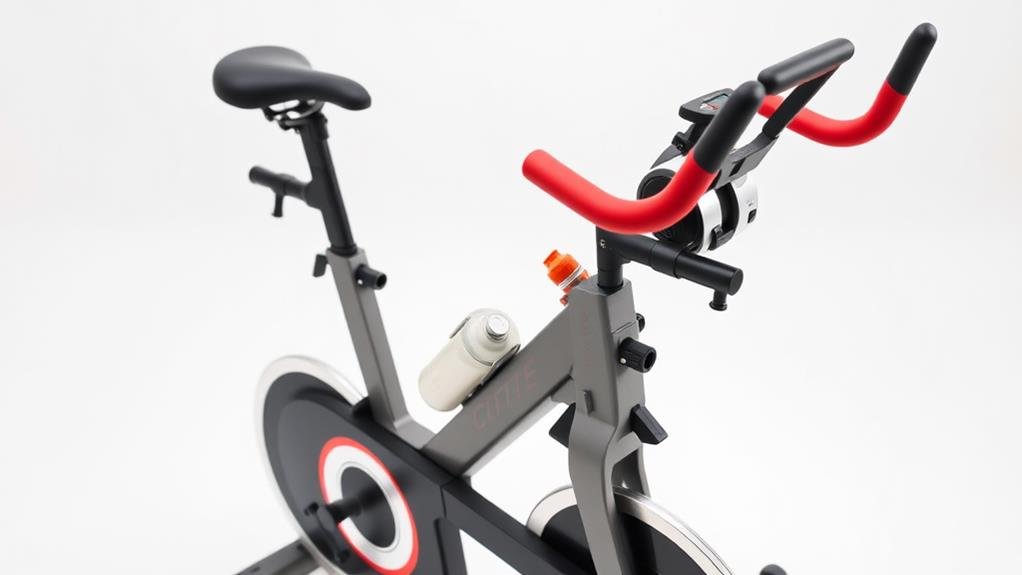
When investing in a spin bike, several key features warrant careful evaluation before making a purchase decision. Let's examine the main specifications that distinguish different models of Spin exercise bikes and help determine the best fit for your needs.
First, we'll consider the power source requirements. While the IC4 operates via wall adapter, the IC3 Indoor Cycling model runs on two AA batteries, which impacts placement flexibility in your workout space.
The flywheel weight is another essential factor, with Spin bikes featuring a substantial 40-pound perimeter-weighted system that guarantees smooth operation and consistent resistance.
Weight capacity varies across models, accommodating users between 300-330 pounds, making these bikes suitable for most riders. Warranty coverage is equally significant – we see notable differences between the IC4's 10-year frame warranty and the IC3's 5-year coverage.
Price points range considerably, from $699 for the IC3 to $1,745 for premium models like the Blade ION and Aero series. Additional value comes from included accessories, as both IC3 and IC4 models ship with complimentary exercise mats and free delivery within the United States.
Proper Bike Setup and Position
Having selected a spin bike with the right features, proper setup becomes essential to maximizing your investment. When arranging your indoor cycling position, we suggest starting with seat height adjustments. The seat should align with your hip level when standing next to the bike, allowing for best leg extension during pedaling cycles.
We'll want to focus on handlebar positioning next, as it's vital for maintaining proper form during your indoor cycling sessions. Adjust the handlebars to a height that allows your spine to maintain a neutral position, preventing unnecessary strain on your back and shoulders. Your elbows should have a slight bend when gripping the handlebars.
Proper foot positioning on the pedals is equally significant for efficient power transfer and injury prevention. We recommend centering the ball of your foot over the pedal spindle. Throughout your ride, maintain awareness of your spine alignment – keep it neutral rather than rounded or overextended. These setup principles guarantee you'll get the most from your bike workouts while minimizing discomfort and risk of injury. Remember, taking time to properly adjust your bike position will greatly enhance both your performance and riding experience.
Connected Fitness Technology Options
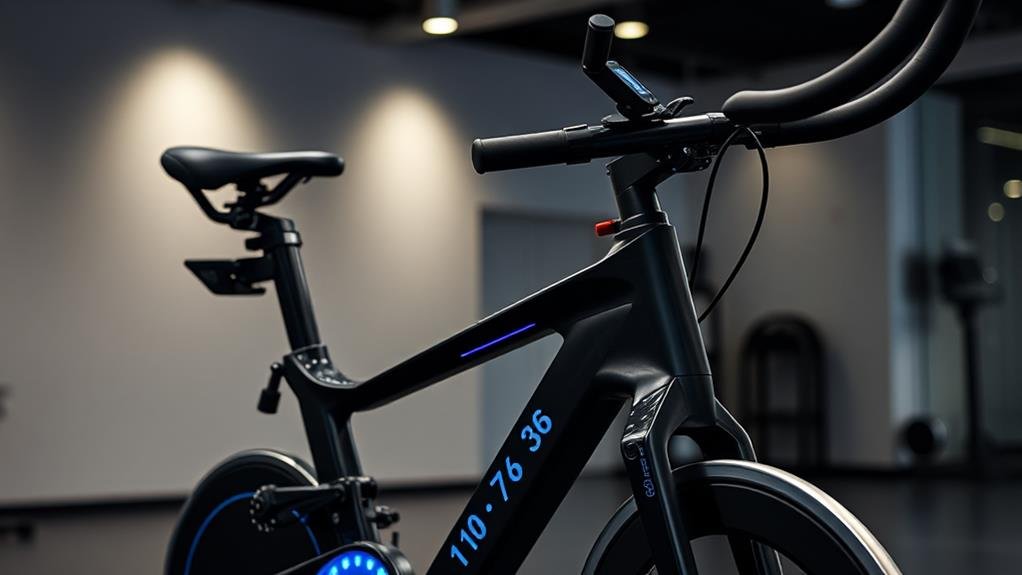
Connected fitness technology enhances the indoor cycling experience through seamless integration of digital features and interactive capabilities. Modern spin bikes, from Connected Spinners to Peloton Bikes, now incorporate sophisticated technology that transforms our workouts into immersive, data-driven sessions.
We're seeing an increasing number of bikes equipped with built-in HD screens or device mounts that let's stream live and on-demand classes while tracking essential performance metrics. These smart bikes feature Bluetooth and Wi-Fi connectivity, enabling seamless synchronization with popular cycling apps and fitness platforms. When combined with SPD clips for best power transfer, we're able to maximize both our performance and the technology's capabilities.
The integration of connected fitness features provides us with real-time feedback on cadence, resistance, and power output. We can join virtual group rides, compete on global leaderboards, and follow structured training programs tailored to our fitness goals. This technology also allows us to store and analyze our workout history, track improvements over time, and adjust our training intensity based on data-driven insights, making every session more purposeful and effective.
Maintenance and Care Guidelines
Through proper upkeep and attention, we can prolong our spin bike's lifespan while ensuring peak performance during every workout. Whether we own Peloton Bikes or other exercise bike models, following necessary maintenance protocols is vital for ideal functionality.
We must regularly wipe down our bike after each session, using a damp cloth to remove sweat and dirt from the frame, seat, and handlebars. This prevents corrosion and maintains hygiene. Our routine should include checking and tightening all mechanical components, especially the bolts, pedals, and handlebar adjustments, to ensure stability during intense workouts.
Proper lubrication of the chain and moving parts is crucial, and we should strictly follow the manufacturer's guidelines for timing and product selection. We'll need to monitor and adjust the drive belt or chain tension regularly to maintain consistent resistance levels.
Additionally, positioning our exercise bike on a level surface and protecting it from environmental extremes will greatly reduce wear and prevent premature component failure. These maintenance steps are particularly important for connected bikes with advanced electronics and mechanical systems.
Space Requirements and Storage
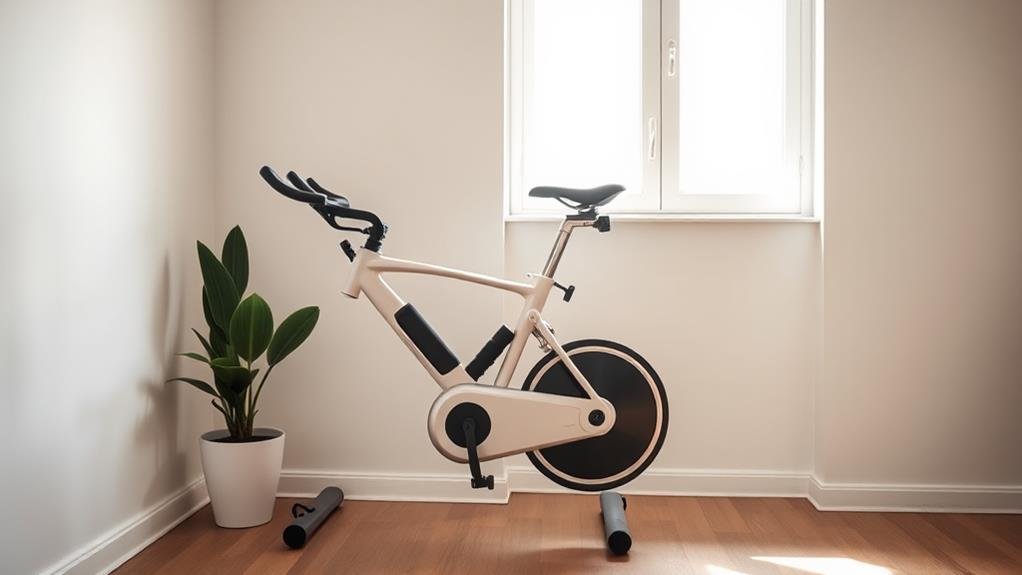
Efficient space management plays an essential role when incorporating a spin bike into our home gym setup. We'll need to allocate approximately 3 feet by 4 feet of floor space to guarantee comfortable and safe operation of the equipment. The compact design of modern spin bikes makes them particularly suitable for home use, with many models featuring space-saving options like transport wheels for easy relocation.
| Feature | Benefit |
|---|---|
| Transport Wheels | Easy movement between rooms |
| Folding Capability | Reduced storage footprint |
| Compact Design | Maximizes available space |
| Standard Dimensions | Predictable space planning |
| Portable Weight | Simple repositioning |
When selecting a spin bike, we'll want to carefully measure the dimensions of our intended workout area and compare them to the specifications of potential models. Many manufacturers now offer folding spin bikes, which provide additional flexibility for homes where space is at a premium. These collapsible options can be particularly valuable in apartments or shared living spaces where we need to optimize every square foot. Remember to factor in additional clearance around the bike for safe mounting, dismounting, and maintenance access.
Popular Brands and Models
Among today's leading spin bike manufacturers, several brands stand out for their innovative features and reliable performance. We find that connected fitness experiences have become increasingly important, with models like the Blade ION Connected Spinner® and Peloton Bike+ leading the charge in smart technology integration. These bikes typically feature a device holder for tablets or phones, enabling riders to access various training apps and virtual classes.
The market offers options at different price points, making quality spin bikes accessible to various budgets. The Schwinn IC4, priced at $999.00, delivers excellent value with Bluetooth connectivity and compatibility with popular fitness apps, including the Peloton app. The Bowflex C6 represents another strong contender in the connected fitness space.
- Premium Connected Options:
- Blade ION Connected Spinner® ($1,745.00)
- Peloton Bike+ (Premium connectivity features)
- A5 Connected Spinner® ($895.00)
- Mid-Range Solutions:
- Schwinn IC4 ($999.00)
- Bowflex C6 (Bluetooth-enabled)
- Key Features to Evaluate:
- App compatibility
- Device holder configuration
- Connectivity options
Pedal Systems and Compatibility
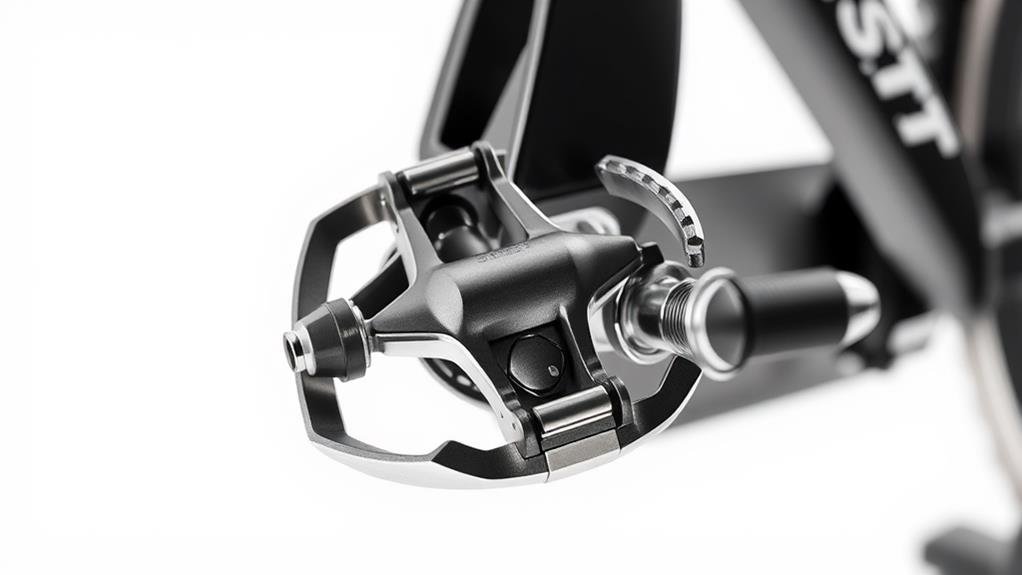
On modern spin bikes, pedal systems represent an important component that directly impacts both performance and versatility. We'll often find dual-sided pedals that cater to both SPD cleats and regular athletic shoes, offering maximum flexibility for different riding preferences.
| Pedal Type | Advantages | Best For |
|---|---|---|
| Dual-sided | Flexible, suits all footwear | Mixed-use facilities |
| Clipless | Maximum power transfer, security | Dedicated cyclists |
| Toe cage | Compatibility with regular shoes | Casual riders |
When selecting a spin bike, we need to take into account the pedal system's impact on our workout efficiency. Clipless pedals require specific cycling shoes with cleats, providing a secure connection that enhances power transfer and control during intense sessions. For those who prefer using regular athletic shoes, models equipped with toe cages offer a practical alternative while maintaining stability during workouts.
Understanding pedal compatibility is important for facility managers and home users alike. We'll find that most commercial-grade spin bikes come with dual-sided pedals as standard, accommodating both cleated and non-cleated users. This flexibility ensures that riders can choose their preferred pedaling method without compromising the workout experience.
Workout Programs and Training
Modern spin bikes combine advanced pedal systems with sophisticated workout programming to create all-inclusive training experiences. These machines offer all-encompassing training programs that cater to riders of all skill levels, enabling us to enhance our cardiovascular fitness through structured workouts. We'll find that most contemporary models feature pre-programmed sessions designed to simulate real-world cycling scenarios, making indoor training both effective and engaging.
When we explore the available workout options, we'll discover three primary training categories:
- Endurance rides – Long, steady-state sessions focusing on building stamina and aerobic capacity
- High-intensity interval training (HIIT) – Short, intense bursts alternating with recovery periods
- Hill climbs – Progressive resistance adjustments simulating elevation changes
We can greatly improve our fitness levels by incorporating these varied training programs into our routines. The ability to stream live or on-demand classes adds another dimension to our workouts, providing professional guidance and motivation.
Through consistent training on spin bikes, we'll develop stronger lower body muscles, increase our endurance capacity, and experience notable enhancements in our overall physical and mental well-being.
Conclusion
As we've navigated through the vast landscape of indoor cycling technology, it's clear that spin bikes represent more than just exercise equipment—they're gateways to peak cardiovascular performance. We've examined resistance mechanisms, connectivity features, and proper biomechanics that define today's advanced systems. Whether you're pursuing structured training or casual fitness, we'll continue seeing spin bikes evolve as centerpieces of modern fitness technology.
